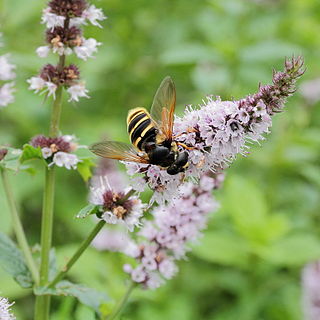
Mentha is a genus of plants in the family Lamiaceae. The exact distinction between species is unclear; it is estimated that 13 to 24 species exist. Hybridization occurs naturally where some species' ranges overlap. Many hybrids and cultivars are known.

Anagallis arvensis, commonly known as the scarlet pimpernel, red pimpernel, red chickweed, poor man's barometer, poor man's weather-glass, shepherd's weather glass or shepherd's clock, is a species of low-growing annual plant with brightly coloured flowers, most often scarlet but also bright blue and sometimes pink. The native range of the species is Europe and Western Asia and North Africa. The species has been distributed widely by humans, either deliberately as an ornamental flower or accidentally. A. arvensis is now naturalised almost worldwide, with a range that encompasses the Americas, Central and East Asia, the Indian Subcontinent, Malesia, the Pacific Islands, Australasia and Southern Africa.
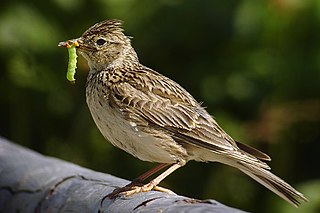
The Eurasian skylark is a passerine bird in the lark family, Alaudidae. It is a widespread species found across Europe and the Palearctic with introduced populations in New Zealand, Australia and on the Hawaiian Islands. It is a bird of open farmland and heath, known for the song of the male, which is delivered in hovering flight from heights of 50 to 100 metres. The sexes are alike. It is streaked greyish-brown above and on the breast and has a buff-white belly.
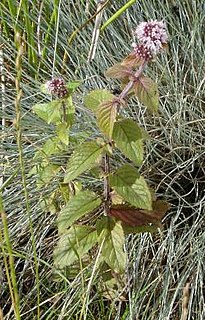
Mentha aquatica is a perennial flowering plant in the mint family Lamiaceae. It grows in moist places and is native to much of Europe, northwest Africa and southwest Asia.
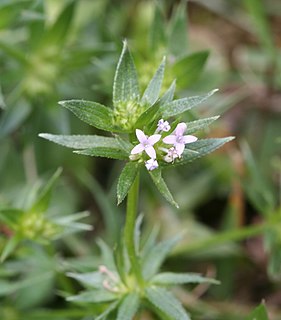
Sherardia is a monotypic genus of flowering plants in the family Rubiaceae. The genus contains only one species, viz. Sherardia arvensis or (blue) field madder, which is widespread across most of Europe and northern Africa as well as southwest and central Asia and Macaronesia. It is also reportedly naturalized in Australia, New Zealand, Taiwan, Kerguelen, Ethiopia, Sudan, southern Africa, Mexico, Costa Rica, South America, Bermuda, Cuba, Haiti and much of Canada and the United States.

Mentha arvensis, the corn mint, field mint, or wild mint, is a species of flowering plant in the mint family Lamiaceae. It has a circumboreal distribution, being native to the temperate regions of Europe and western and central Asia, east to the Himalaya and eastern Siberia, and North America. Mentha canadensis, the related species, is also included in Mentha arvensis by some authors as two varieties, M. arvensis var. glabrata Fernald and M. arvensis var. piperascens Malinv. ex L. H. Bailey.

Convolvulus arvensis, the field bindweed, is a species of bindweed that is rhizomatous and is in the morning glory family (Convolvulaceae), native to Europe and Asia. It is a climbing or creeping herbaceous perennial plant with stems growing to 0.5–2 metres in length, usually found at ground level, with small, white and pink flowers.

Anthemis arvensis, also known as corn chamomile, mayweed, scentless chamomile, or field chamomile is a species of flowering plant in the genus Anthemis, in the aster family. It is used as an ornamental plant.

Sinapis arvensis, the charlock mustard, field mustard, wild mustard or charlock, is an annual or winter annual plant of the genus Sinapis in the family Brassicaceae. It is found in the fields of North Africa, Asia and Europe. Pieris rapae, the small white butterfly, and Pieris napi, the green veined white butterfly are significant consumers of charlock during their larval stages.

Sonchus arvensis, the field milk thistle, field sowthistle, perennial sow-thistle, corn sow thistle, dindle, gutweed, swine thistle, or tree sow thistle, is a species of flowering plant in the daisy family Asteraceae. S. arvensis often occurs in annual crop fields and may cause substantial yield losses.
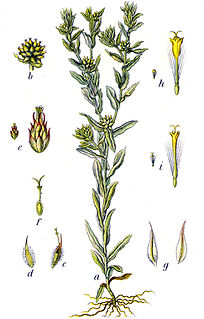
Filago vulgaris or Filago germanica, commonly known as common cudweed or common cottonrose, is an annual herbaceous plant of the genus Filago. It is in the tribe Inuleae of the sunflower family, Asteraceae. Common names also include: Danish—Kugle-museurt, and Norwegian—Kuleullurt.

Mentha canadensis is a species of mint native to North America and the eastern part of Asia. In North America, it is commonly known as Canada mint, American wild mint, and in Asia as Chinese mint, Sakhalin mint, Japanese mint, and East Asian wild mint. The flowers are bluish or have a slight violet tint. The plant is upright, growing to about 4–18 in (10–46 cm) tall. Leaves grow opposite from each other, and flower bunches appear in the upper leaf axils. The mint grows in wet areas but not directly in water, so it will be found near sloughs, and lake and river edges. Plants bloom from July to August in their native habitats.

Filago is a genus of plants in the sunflower family, native to Europe, Asia, and North Africa. They are sometimes called cottonroses or cudweeds.

Calendula arvensis is a species of flowering plant in the daisy family known by the common name field marigold. It is native to central and southern Europe, and it is known across the globe as an introduced species.
Coleophora filaginella is a moth of the family Coleophoridae. It is found in Finland, Latvia, Germany and Greece.

Digitivalva reticulella is a moth of the family Acrolepiidae found in most of Europe, except Ireland, Great Britain, the Netherlands, France, Portugal, Slovenia, much of the Balkan Peninsula, and Lithuania.
Filago prolifera is a species of flowering plant in the sunflower family, Asteraceae. It is native to northern Africa and the Arabian peninsula.

Filago pyramidata, common name broadleaf cottonrose or broad-leaved cudweed, is a European plant species in the sunflower family. It is native to the Mediterranean region of southern Europe, northern Africa, and the Middle East, plus Great Britain, the Low Countries, and Germany. It is also naturalized in scattered locations in North America and Australia, Pakistan, and other places.

Nigella arvensis, the field nigella or wild fennel flower, is a species of flowering plant in the family Ranunculaceae. It is native to North Africa, central, southern and eastern Europe, the Caucasus region, and the Middle East as far as Iran, and has gone extinct in Switzerland and Crete. It is a minor crop, used locally as a substitute for Nigella sativa, black caraway.

Moricandia arvensis, the purple mistress, is a species of flowering plant in the family Brassicaceae. It has a broadly western Mediterranean distribution, from the Canary Islands to northern Africa including Mauritania and Chad, the Iberian Peninsula, Italy and as far as Greece, and has been introduced to France, Corsica, and Sardinia. It has a mixed C3–C4 carbon fixation system.


















